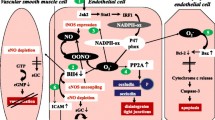Abstract
Dehydroascorbic acid (DHA), a blood–brain barrier transportable form of ascorbic acid, confers robust neuroprotection following murine stroke. In an effort to translate this promising neuroprotective strategy into human clinical trial, we evaluated postischemic DHA administration in a large-animal stroke model. Thirty-six adult male baboons were initially randomized to undergo transorbital craniectomy to induce transient cerebral artery occlusion and to receive postischemic dosing of either 500 mg/kg of DHA or vehicle. Primary outcomes included infarct volume, determined by magnetic resonance imaging, as well as neurological function evaluated on the day of sacrifice. The midpoint interim analysis (n = 9 per cohort) revealed that DHA administration did not significantly improve either infarct volume or neurological function. The study was terminated after a determination of statistical futility. We were unable to confirm a neuroprotective effect for postischemic DHA administration in our large-animal model using a dosing scheme that was previously successful in rodents. Further analysis of the efficacy of DHA administration must thus be undertaken prior to clinical translation.

Similar content being viewed by others
References
Brouns R, De Deyn PP. The complexity of neurobiological processes in acute ischemic stroke. Clin Neurol Neurosurg. 2009;111(6):483–95.
Doyle KP, Simon RP, Stenzel-Poore MP. Mechanisms of ischemic brain damage. Neuropharmacology. 2008;55(3):310–8.
Niizuma K, Endo H, Chan PH. Oxidative stress and mitochondrial dysfunction as determinants of ischemic neuronal death and survival. J Neurochem. 2009;109 Suppl 1:133–8.
Wolin MS, Davidson CA, Kaminski PM, Fayngersh RP, Mohazzab HK. Oxidant–nitric oxide signalling mechanisms in vascular tissue. Biochemistry (Mosc). 1998;63(7):810–6.
Gilgun-Sherki Y, Rosenbaum Z, Melamed E, Offen D. Antioxidant therapy in acute central nervous system injury: current state. Pharmacol Rev. 2002;54(2):271–84.
Chacon MR, Jensen MB, Sattin JA, Zivin JA. Neuroprotection in cerebral ischemia: emphasis on the SAINT trial. Curr Cardiol Rep. 2008;10(1):37–42.
Hall ED, Andrus PK, Smith SL, Oostveen JA, Scherch HM, Lutzke BS, et al. Neuroprotective efficacy of microvascularly-localized versus brain-penetrating antioxidants. Acta Neurochir Suppl. 1996;66:107–13.
Mack WJ, Mocco J, Ducruet AF, Laufer I, King RG, Zhang Y, et al. A cerebroprotective dose of intravenous citrate/sorbitol-stabilized dehydroascorbic acid is correlated with increased cerebral ascorbic acid and inhibited lipid peroxidation after murine reperfused stroke. Neurosurgery. 2006;59(2):383–8. Discussion 8.
Huang J, Agus DB, Winfree CJ, Kiss S, Mack WJ, McTaggart RA, et al. Dehydroascorbic acid, a blood-brain barrier transportable form of vitamin C, mediates potent cerebroprotection in experimental stroke. Proc Natl Acad Sci USA. 2001;98(20):11720–4.
Ducruet AF, Grobelny BT, Zacharia BE, Hickman ZL, Yeh ML, Connolly ES. Pharmacotherapy of cerebral ischemia. Expert Opin Pharmacother. 2009;10(12):1895–906.
Stroke Therapy Academic Industry Roundtable II (STAIR II). Recommendations for clinical trial evaluation of acute stroke therapies. Stroke. 2001;32(7):1598–606.
Fisher M, Feuerstein G, Howells DW, Hurn PD, Kent TA, Savitz SI, et al. Update of the stroke therapy academic industry roundtable preclinical recommendations. Stroke. 2009;40(6):2244–50.
Fisher M. Recommendations for advancing development of acute stroke therapies: Stroke Therapy Academic Industry Roundtable 3. Stroke. 2003;34(6):1539–46.
Huang J, Mocco J, Choudhri TF, Poisik A, Popilskis SJ, Emerson R, et al. A modified transorbital baboon model of reperfused stroke. Stroke. 2000;31(12):3054–63.
Mack WJ, Komotar RJ, Mocco J, Coon AL, Hoh DJ, King RG, et al. Serial magnetic resonance imaging in experimental primate stroke: validation of MRI for pre-clinical cerebroprotective trials. Neurol Res. 2003;25(8):846–52.
Mack WJ, King RG, Hoh DJ, Coon AL, Ducruet AF, Huang J, et al. An improved functional neurological examination for use in nonhuman primate studies of focal reperfused cerebral ischemia. Neurol Res. 2003;25(3):280–4.
Mocco J, Choudhri T, Huang J, Harfeldt E, Efros L, Klingbeil C, et al. HuEP5C7 as a humanized monoclonal anti-E/P-selectin neurovascular protective strategy in a blinded placebo-controlled trial of nonhuman primate stroke. Circ Res. 2002;91(10):907–14.
Mocco J, Mack WJ, Ducruet AF, King RG, Sughrue ME, Coon AL, et al. Preclinical evaluation of the neuroprotective effect of soluble complement receptor type 1 in a nonhuman primate model of reperfused stroke. J Neurosurg. 2006;105(4):595–601.
Ducruet AF, Mocco J, Mack WJ, Coon AL, Marsh HC, Pinsky DJ, et al. Pre-clinical evaluation of an sLe x-glycosylated complement inhibitory protein in a non-human primate model of reperfused stroke. J Med Primatol. 2007;36(6):375–80.
Sughrue ME, Mocco J, Mack WJ, Ducruet AF, Komotar RJ, Fischbach RL, et al. Bioethical considerations in translational research: primate stroke. Am J Bioeth. 2009;9(5):3–12.
Hoyte L, Kaur J, Buchan AM. Lost in translation: taking neuroprotection from animal models to clinical trials. Exp Neurol. 2004;188(2):200–4.
Quencer RM, Parker JC, Hinkle DK. Maturation of normal primate cerebral tissue: preliminary results of a computed tomographic-anatomic correlation. J Comput Assist Tomogr. 1980;4(4):464–5.
Johnson FC. The antioxidant vitamins. CRC Crit Rev Food Sci Nutr. 1979;11(3):217–309.
Bemeur C, Ste-Marie L, Desjardins P, Vachon L, Butterworth RF, Hazell AS, et al. Dehydroascorbic acid normalizes several markers of oxidative stress and inflammation in acute hyperglycemic focal cerebral ischemia in the rat. Neurochem Int. 2005;46(5):399–407.
Ekici F, Ozyurt B, Erdogan H. The combination of vitamin D3 and dehydroascorbic acid administration attenuates brain damage in focal ischemia. Neurol Sci. 2009;30(3):207–12.
Acknowledgments
The authors would like to thank Daniel Batista for his expert technical assistance. Portions of this study were supported by Progenics, Inc.
Conflict of interest
Portions of this study were supported by Progenics, Inc.
Author information
Authors and Affiliations
Corresponding author
Rights and permissions
About this article
Cite this article
Ducruet, A.F., Mack, W.J., Mocco, J. et al. Preclinical Evaluation of Postischemic Dehydroascorbic Acid Administration in a Large-Animal Stroke Model. Transl. Stroke Res. 2, 399–403 (2011). https://doi.org/10.1007/s12975-011-0084-2
Received:
Revised:
Accepted:
Published:
Issue Date:
DOI: https://doi.org/10.1007/s12975-011-0084-2




